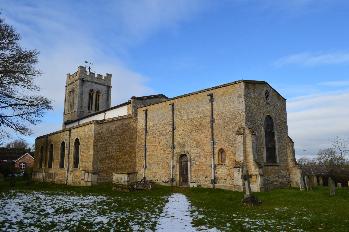Early Education in Melchbourne

The church from the south-east February 2014
Volume 81 published by Bedfordshire Historical Records Society (2002) is a series of episcopal visitationsundertaken in the first twenty years of the 18th century, edited by former County Archivist Patricia Bell. At each visitation a list of questions was sent out in advance, one of which enquired about the provision of schools in each parish. The responses are as follows:
- 1706: "There is neither Lecture, School, Almeshouse, nor Hospital within this parish".
- 1709: "No public or Charity Schole established. The Vicar during pleasure pays for teaching the poor children to read, and day their Catechism".
- 1712: "12 Children taught at the Vicar's expence".
- 1717: "No Publick or Charity School".
- 1720: "Five poor Children are yearly taught by a Widow Woman at the Charitable expence of the right Honble. William Lord Saint John".
In 1818 a Select Committee was established to enquire into educational provision for the poor. This was no doubt prompted, in part, by the recent foundation of two societies promoting education and specifically the building of schools. The Society for Promoting the Lancasterian System for the Education of the Poorwas established in 1808 promoting schools run along the lines pioneered by Joseph Lancaster, who had himself copied those of Dr.Andrew Bell, in which older children taught their younger fellows. The Society was renamed the British and Foreign School Society in 1814. It was supported by a number of prominent nonconformists, Lancaster himself was a Quaker, and sought to teach a non-sectarian curriculum. In answer to this perceived nonconformist takeover of local education the National Society was formed in 1811 to encourage the teaching of poor children along Anglican lines, including the catechism. The Select Committee sent a questionnaire to all parishes in the country asking for: particulars relating to endowments for the education of children; other educational institutions; observations of parish needs etc. The return for Melchbourne stated that there was no daily school but a Sunday school consisting of about forty children. In those days a Sunday School was just that, a school which met on a Sunday, usually in the church or nonconformist chapel or other similar building, teaching more than the religious topics with which they are associated today. The curate wrote: "The poor in general readily embrace the means of education afforded them".
In the country generally the number of schools built continued to grow over the next fifteen years so that by 1833 the government agreed to supplement the work of the two societies, and local benefactors, by making £20,000 per annum available in grants to help build schools. It also prompted another questionnaire to be sent to each parish in England asking for details of local educational provision. The return for Melchbourne noted that there was an infant school consisting of fifteen children supported by payments from parents and from subscriptions. The subscription supported Sunday school had thirty children.
The next national enquiry was in 1846/7 when the Church of England made an enquiry as to all its church schools. This was against the background of a new Whig government which championed secular education and the increasing importance of nonconformists, particularly Wesleyan Methodist, and Roman Catholics in providing schools. The Melchbourne return noted the Sunday school for 22 boys and 30 girls as well as a dame's school for five boys and twelve girls. This may be the daily school noted in 1833. The preponderance of girls suggests it may have been a lace school where children supposedly learned to read and write as well as making lace which was then sold; all too often in such establishments the latter activity excluded the former.
The first Education Act was passed in 1870 (more correctly it was known as the Elementary Education Act). It was a milestone in the provision of education in Britain demonstrating central government's unequivocal support for education of all classes across the country. It also sought to secularise education by allowing the creation of School Boards. These were groups of representatives, elected by the local ratepayers and the Board had the powers to raise funds to form a local rate to support local education, build and run schools, pay the fees of the poorest children, make local school attendance compulsory between the ages of 5 and 13 and could even support local church schools, though in practice they replaced them, turning them into Board run schools (known as Board Schools). Naturally, and luckily for local historians, the Act required a questionnaire of local schools in 1870. Melchbourne had a private elementary school for 54 children.

The Old School February 2014